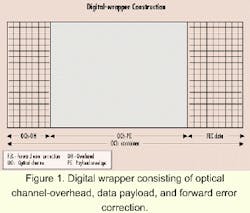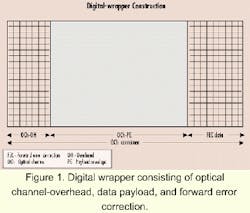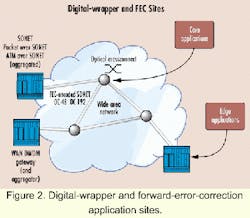Implementing 10-Gbit digital-wrapper structure for efficient transport over OC-192
The digital wrapper uniformly handles transport overhead, while still providing enough flexibility to handle a wide range of implementations.
BY ALAN SORGI, KEN PRENTISS, AND GEORGE BENDAK, AMCC
Today's metropolitan-area-network (MAN) and wide-area-network (WAN) internetworking infrastructures are facing a number of significant new challenges due to the combined impacts of escalating optical-networking speeds, the proliferation of optical channels, and the convergence trends toward carrying a variety of heterogeneous traffic types on the same network.
First, the ongoing migration up to OC-192 10-Gbit speeds has made integrated forward error correction (FEC) a key ingredient for overcoming optical noise, attenuation, and dispersion to maintain acceptable link distances at higher speeds. Second, the rise of DWDM is rapidly multiplying the number of channels that must be handled by enabling separate optical signals to be carried on specific wavelengths across the same physical fiber. Third, as the worlds of telecom and datacom are merging at 10-Gbit levels, there is a critical need for efficient mechanisms to aggregate a variety of traffic types-Internet Protocol, voice, etc.-over different transport mechanisms such as conventional SONET/SDH, packet over SONET (PoS), or ATM over SONET.
To deal with these issues in a comprehensive fashion, the networking industry is now turning to the use of a "digital wrapper" at 10-Gbit/sec levels and higher. The digital-wrapper concept essentially defines a high-level envelope structure for uniformly handling transport overhead and FEC functions, while still providing ample flexibility to handle a wide range of specific FEC implementations and/or different data payloads.
We'll explore the challenges of transport convergence and FEC implementation, outline the fundamentals of the digital-wrapper concept, look at specific applications for digital-wrapper technology, and investigate the semiconductor-level issues involved with effectively implementing digital-wrapper and FEC capabilities.
Until recently, the generally accepted methods for managing most optical links have involved the use of SONET and SDH technologies to support signal regeneration as well as monitor, analyze, and control optical channels. Using a time-division multiplexed (TDM) paradigm, the SONET/SDH structure has provided a reliable and robust method for managing all aspects of end-to-end optical links. However, the proliferation of different types of traffic across many different wavelengths on optical backbones has now led the industry to look beyond the limitations of SONET/SDH.
With the growing need to support a variety of heterogeneous LAN and MAN protocols such as IP, ATM, and Gigabit Ethernet directly across multiple wavelengths on optical backbones, it is not always best to manage every optical link by converting all of the "client signals" to TDM-based SONET/SDH formats. While the use of SONET/SDH continues to be very useful, such as for managing optical links that handle specific types of traffic at network termination points, the imposition of SONET/SDH throughout all of the individual wavelengths on DWDM-enabled optical backbones can represent both unnecessary overhead and undesirable inflexibility.
Instead, within next-generation optical transport networks (OTNs), each individual wavelength is managed as a discrete optical channel (OCh) with its own operations, administration, and maintenance (OAM) functions. In the digital-wrapper concept, a small, efficient OAM structure is wrapped around the data payload to uniformly define critical transport-related information, including control functions, restoration signals, traffic types, and traffic destinations.
Another major issue in new-generation OTNs is the need for building in FEC provisions to improve the transport links' optical signal consistency and maintain transmission integrity as optical speeds increase. While specific FEC mechanisms may vary, such as Reed-Solomon or Hamming codes, the basic technique consists of adding a small bit of digital information to the payload to boost the optical signal-to-noise ratio, thereby improving the link's bit-error-rate performance.
Because the distance and capacity of any given link are mutually limited by the link's overall optical noise, attenuation, and dispersion characteristics, increases in capacity can have an inverse impact on distance, thereby reducing achievable transmission link lengths. While this issue has been less of a problem at speeds of up to OC-48's 2.5 Gbits/sec, it has become a key factor for maintaining acceptable transmission link distances at OC-192 10-Gbit/sec levels. For OC-192, the energy per bit is only one-fourth of that for OC-48 over a given fiber link configuration, meaning that OC-192 must effectively overcome four times as much attenuation and dispersion for each kilometer of distance.
As many parts of the OTN infrastructure are now migrating to the higher carrying capacity of OC-192, FEC has become a critical factor for maintaining acceptable span distances at least equivalent to OC-48 spans, thereby avoiding excessive costs for additional repeaters. To effectively transport data across heterogeneous MAN/WAN environments, there is a need for common mechanisms for handling FEC; but at the same time, there must be a certain degree of flexibility for system builders and network designers to tailor their specific FEC implementations to meet different objectives. For example, depending upon traffic types and quality-of-service (QoS) requirements, some networks may need to tradeoff FEC performance against overall payload-carrying capacity, or in some instances the FEC implementation may need to detect errors in larger bursts of data. Here again, the digital-wrapper concept is designed to provide a uniform but flexible envelope for implementing various FEC requirements rather than imposing a single FEC implementation for all situations.
It all began two years ago, with proposals originally put forth by Lucent Technologies. Since then, the concept of a universal digital-wrapper definition has undergone discussions and review by the ANSI T1 Telecommunications Standards Committee (ANSI T1X1.5), the Optical Interface Forum, and the International Telecommunications Union. An overall OCh concept is also reflected in ITU G.872 standards proposals. Currently, the primary movement toward implementing an industry standard digital wrapper definition is embodied by the ITU G.709 draft proposals. Although final actions have yet to be taken by these standards-setting bodies, it is becoming clear that the industry is quickly moving toward the use of some sort of digital wrapper to efficiently provide protocol-independent transport and OAM functions for all client signals across DWDM optical backbones.
In essence, the digital-wrapper concept involves grouping together a number of existing frames into "super-frames," which can then be more efficiently managed with a relatively small allocation of overhead-per-byte of data. By aggregating the provisions for "framing bits" that are already defined for use by existing TDM structures, the super-frame concept allows for the implementation of an intelligent OAM capability without materially expanding the amount of data currently being transmitted. This creative use of available control bits also allows FEC functions to be very efficiently incorporated within the digital-wrapper definition without a significant net increase in overall bandwidth usage.
For example, the current ITU G.709 digital-wrapper proposal defines a basic "frame" to be roughly equivalent to the ITU G.975 frame, with 16 levels of interleaved subframes of 255 bytes. Although each basic frame allows for only 16 bytes of overhead, the digital wrapper's aggregation of four frames into a super-frame results in a total of 64 bytes that can be flexibly used for optical channel-overhead (Och-OH) functions, such as framing, parity check bytes, site-to-site communication, or protection-switching and connection-management functions.As shown in Figure 1, by defining a consistent structure with all of the OCh-OH and FEC functions specified separately from the data payload, the digital wrapper essentially provides a highly flexible, self-managed, protocol-independent "container" for efficiently transporting virtually any type of data across DWDM optical links.
In essence, the individual framing bits that would have been routinely transmitted anyway with every frame are instead aggregated and reallocated to establish a robust and efficient in-band transport management structure. Regardless of the differences in various native protocols, formats, or data rates, the digital-wrapper concept with integrated FEC enables the optical backbone infrastructure to uniformly interpret, route, manage, and control the performance of any blend of accuracy levels for any blend of heterogeneous traffic such as IP, ATM, Gigabit Ethernet, video, and voice. By defining an integrated structure for FEC, the digital wrapper also lays the groundwork for migrating to 10-Gbit/sec OC-192 without a significant reduction of achievable link distances.
To be truly effective, the digital-wrapper concept needs to be implementable across a number of different traffic aggregation points and transport scenarios throughout the MAN/WAN internetworking environment. In addition to providing SONET-like functions for convergence of different traffic types within the new global optical network, the digital wrapper also has to provide backward compatibility with conventional SONET structures. As shown in Figure 2, some of these key real-world application sites for digital wrapper and FEC include:
- Edge applications for aggregating native traffic into SONET, PoS, or ATM over SONET data streams.
- WAN DWDM gateways and aggregation points.
- Core applications for high-speed switching and forwarding of aggregated data streams.
While the 10-Gbit digital wrapper provides the overall superstructure for efficiently transporting traffic across the global optical network, it must also support real-world requirements for mapping any type of traffic into the wrapper and flexibly aggregating or de-aggregating individual data streams at various points throughout the network.
Within each of these applications scenarios, system builders also need to be able to efficiently integrate digital-wrapper processing with unique or specialized requirements such as proprietary scrambling algorithms, FEC coding methods, and/or overhead structures. In addition, service providers need to have the flexibility for implementing various QoS scenarios within the digital-wrapper construct as well as for real-time provisioning or reconfiguration of customer-specific transport links and service criteria. The systems must also support service-provider requirements for flexible bandwidth allocation, integrated performance monitoring, and traffic-based billing functions.
From a semiconductor-level perspective, that means next-generation devices must flexibly combine a variety of digital-wrapper and FEC processing capabilities at the chip level. Chip-level implementations need to integrate both the high-speed processing performance needed for OC-192 framing/deframing along the FEC and performance-monitoring functions needed to support transmission quality and overall network integrity. In addition, because the digital-wrapper standards themselves are continuing to evolve, it is important that semiconductor-level devices also include sufficient programmability and extensibility to implement future FEC and digital-wrapper changes as required.
To allow optimal implementation alternatives for system builders, some of the specific chip-level design requirements should include:
- Compliance with existing ITU G.709 proposed standards.
- Framing/deframing and FEC processing performance capable of handling 10-Gbit/sec OC-192 data-stream requirements.
- Variable-rate capabilities to accommodate mixed OC-48 and OC-192 transport environments.
- Built-in performance monitoring using OCh, OAM, and SONET overhead information.
- Ability to independently configure input and output ports to support a wide range of connection scenarios and FEC encoding/decoding mechanisms.
- Flexibility for implementing framing/ deframing with or without FEC.
This combination of high-performance, integrated functions and inherent flexibility will allow the same new-generation semiconductor-level devices to provide a common foundation for implementing universal digital-wrapper and FEC processing functions throughout the global optical infrastructure. Whether the requirement is for DWDM transport systems, aggregation at the MAN edge, protocol-independent transport across MAN/WAN structures, or high-speed core switching and optical crossconnect functions, the same chip-level building blocks can be put to effective use.
For system builders, network architects, and service providers, the ability to cost-effectively implement digital-wrapper and FEC mechanisms throughout the optical infrastructure at 10-Gbit/sec speeds has paved the way for creating tomorrow's truly comprehensive optical-network infrastructures. These new optical networks will gracefully blend DWDM capabilities into mixed OC-48 and OC-192 transport structures. The bottom line is that the inherent flexibility embodied in the digital-wrapper concept will allow disparate traffic types to flow efficiently across heterogeneous transport links in a seamless end-to-end environment that minimizes protocol conversions and maximizes overall network performance.
Alan Sorgi is director of applications engineering, Ken Prentiss is director of marketing, and George Bendak is staff applications engineer at AMCC (San Diego).


